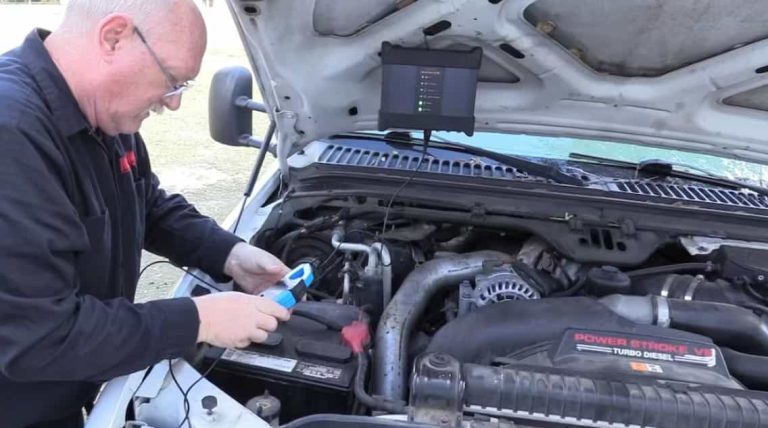Are you concerned about a 7.3 powerstroke no power when cold issues?
A powerstroke engine is robust and highly capable. But when problems occur, it can get quite inconvenient.
Yet when it comes to the hierarchy of diesel-engine, the 7.3L powerstroke is an average performer. Moreover, there is a mixed bag of opinions on whether it is something people particularly like or hate.
Overall, the 7.3L powerstroke is a tireless, hard worker of an engine. Additionally, it is designed to run for as long as possible. But this is only possible when you provide diligent maintenance to it. Furthermore, reasonable hauling and towing are important to ensure its long lifespan and performance.
In terms of the internal components, it is dependable without any doubt. Yet at the same time, it is not popularly known for being high-performance as an engine unless there are modifications made to it.
Today, we will talk more about the reasons why there is no power to your 7.3L powerstroke when cold. Keep reading to learn more.

7.3 Powerstroke No Power When Cold
While there are numerous benefits to this engine, there are a few little issues with it. For example, it is known to have starting issues no matter how much you crank it. This is often the issue when it is cold.
This is why today, we will enumerate some of the reasons why this happens and what you can do about it. Here they are:
1. Battery
No matter how much cranking you do, the 7.3L powerstroke engine will never start despite cranking over unless the battery has sufficient power. The ECM needs ample voltage to make sure the engine works.
On the other hand, a low battery issue will prevent your glow plugs from being able to warm properly. This is particularly true in the cold weather. Thus, the engine is not able to turn fast enough for it to fire up and start.
2. Block heaters and glow plugs
If you are trying to start your diesel engine on a cold morning, you need to do a little work-around to get it to work. But do keep in mind that your block heaters or glow plugs are capable of starting any diesel engine even if it is frigid outside. Your glow plugs heat your internal combustion chamber, therefore achieving a favorable condition for compression and ignition.
3. Wait on your glow plugs
Do you notice that your combustion chamber is not properly heated? When there is not enough heat with your glow plugs, the diesel fuel will simply gel up and then get stuck to your cylinder heads. As a result, the wall or surface of the heads may incur some damage.
4. Putting a second battery.
Now, you need to make sure that your battery is fully charged to fire up the engine. Or as an alternative, you can install another battery, which is only to be used for your glow plugs. But do keep in mind that your glow plugs do not necessarily work unless there is some good amount of power from your battery.
Also, when it is cold, your battery is not fully capable of holding a charge. For example, it may have 100 percent power at up to 80 degrees Fahrenheit. Yet, once the temperature hits zero, the available power may be as little as 46 percent. This is why it is beneficial to have another battery installed to be able to crank your motor.
5. Oil change
Your engine is much harder to start when it is zero degrees or below zero because of the thick oil that lubricates the engine’s hard internal parts. When your oil is so thick, there is a greater resistance on your bearing and other moving parts.
Additionally, you may not realize that your crankshaft is not sitting on your bearings. Instead, it is your oil pressure responsible for lifting up the crankshaft. Therefore, it floats over your bearings in a lot of oil. So, you need to keep your oil fresh and high quality to make sure that your diesel engine’s internal parts get the proper lubrication they need.
You should be fine with natural mineral or synthetic oils for your diesel engine. But oil typically becomes less optimal due to capturing in your suspension. Any chemical by-products including acids and silicon oxide become stuck in the suspension during the combustion cycle. As a result, it is no longer as viscous as it used to be. Chemical reactions, pressure and heat are all elements that destabilize your engine oil.
6. Accessories
When you are having a difficult time starting your engine, it is best to turn your non-essential accessories off. You have insufficient battery power when trying to fire up your engine on a cold day. So you should go easy on your usage of radios, phone chargers, AC, heater, and headlights. These use up batteries, which can prevent you from starting your engine when it is already struggling. Your accessories pull more amps from your glow plugs.
Read More: What Happens If You Overfill Power Steering Fluid?
Bottom Line
Your 7.3 powerstroke may have no power when it is cold. This is a common complaint among owners who experience this issue. Your engine fails to start, and it tends to use up so much power from your battery – and there is already very little of this left because of the cold.
So, we highly advise that you get a second battery for your glow plugs to heat the internal components in preparation for combustion. You should also make sure that your main battery is well-charged. And most importantly, ensure the right engine oil used for proper lubrication. These are just some of the things you can do when you are having difficulties with starting your engine in the cold weather.

